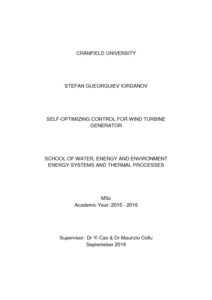Mostra el registre d'ítem simple
School of water, energy and envitornment energy systems and thermal processes
| dc.contributor | Collu, Maurizio |
| dc.contributor.author | Gueorguiev Iordanov, Stefan |
| dc.date.accessioned | 2018-05-09T11:05:17Z |
| dc.date.available | 2018-05-09T11:05:17Z |
| dc.date.issued | 2016-09 |
| dc.identifier.uri | http://hdl.handle.net/2117/117041 |
| dc.description.abstract | The fast development of the wind power technology is leading to larger and more expensive wind turbines which require increasingly advance control systems to achieve optimal or near optimal operation. However, the increased optimality of complex operation schemes, like real-time optimization approaches, incur in high implementation and maintenance costs. Furthermore, while the wind speed is a key variable for the wind turbine control, using it as a direct input leads to a poor response of the power control. This makes the industry focus on simpler control structures, considering wind as a disturbance [1]. Nevertheless, baseline control laws, which perform a deterministic control, require that complex aerodynamic properties are well-known to achieve the desired performance. But in practice, variability bounds the efficiency of the energy capture. Thus, a constrained self-optimizing control is proposed to regulate the wind turbine operation coping with wind speed uncertainty. A data-driven self-optimizing control is proposed for the wind turbine control region where power is maximized (region 2). Operational data is extracted from a model off-line to examine the structure of the optimal solution. This insight is then transformed into a simple control structure capable of keeping the wind turbine to an optimal operation, in terms of maximizing power output. However, at high wind speed, wind turbine power output has to be maintained at its nominal rate. Thus, a cascade control structure for self-optimizing and constrained control is incorporated. The control structure is implemented in Simulink using as a model FAST v8 5MW onshore wind turbine model. The proposed self-optimizing control learns the structure of the optimal solution off-line and then performs the optimization strategy, adjusting both torque and pitch to maximize energy capture. This control approach leads to an increase in power output when comparing it with the deterministic baseline control. Moreover, this heuristic control approach has the potential to take into account a higher number of inputs without compromising reliability. This property allows its future application for more advance control strategies. |
| dc.language.iso | eng |
| dc.publisher | Universitat Politècnica de Catalunya |
| dc.publisher | Cranfield University |
| dc.rights | Attribution-NonCommercial-NoDerivs 3.0 Spain |
| dc.rights.uri | http://creativecommons.org/licenses/by-nc-nd/3.0/es/ |
| dc.subject | Àrees temàtiques de la UPC::Energies::Energia eòlica |
| dc.subject.lcsh | Wind power |
| dc.subject.lcsh | Automatic control |
| dc.title | School of water, energy and envitornment energy systems and thermal processes |
| dc.type | Master thesis |
| dc.subject.lemac | Control automàtic |
| dc.subject.lemac | Energia eòlica |
| dc.rights.access | Open Access |
| dc.audience.educationlevel | Màster |
| dc.audience.mediator | Escola Tècnica Superior d'Enginyeria Industrial de Barcelona |
| dc.audience.degree | MÀSTER UNIVERSITARI EN ENGINYERIA INDUSTRIAL (Pla 2014) |


